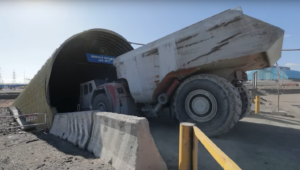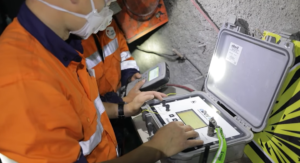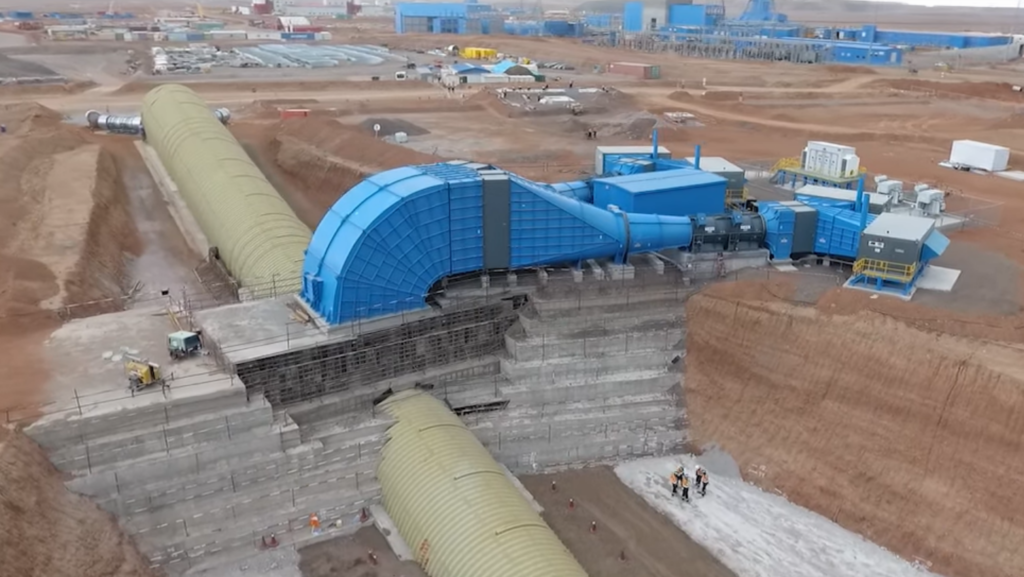Copper-gold mining operation Oyu Tolgoi LLC recently celebrated a significant milestone with the breakthrough heading blasting completed August 16, connecting the C2S project conveyor decline with the underground workings. Tuul Batbayar, Oyu Tolgoi Mining Engineer outlined how significant C2s is for the mine. “The C2S system is a key component of the Oyu Tolgoi underground mine and will be the main means of transporting ore from underground as well as providing direct access to the mine from the surface. The first phase, which consists of the MHS entails production shaft 2 which has a production capacity of 25,000 t/d through the hoisting system and with the second phase, the conveyor to surface system will take the mine to approximately 95,000 t/d of ore.”
The C2S decline is a parallel tunnelling system consisting of three main units – the conveyors 20,21 and 22. Each decline leg is approximately 2,200 m long and 395 m deep, and consists of approximately 16.6 km of tunnels in total with 18% decline angle. Plus it includes two mass excavations of 35,000 m3, the equivalent of a 7 to 8 storey building. thyssenkrupp supplied the overall conveyor system with Siemens undertaking the engineering, design, production and supply of the electrical equipment including both gearless and conventional drives. In all, the transport system consists of a total of nine conveyors – seven underground and two at surface. Four of these conveyor belts have a gearless design, each with two 5.5 MW drive systems.
Contractor Thiess Khishig Arvin Joint Venture LLC (TKAJV), a joint venture between Thiess and local contractor Khishig Arvin, signed a contract to build the decline for Oyu Tolgoi and officially started work on August 6, 2016, currently employing a total of 240. Tuya Gerel, HSET Manager at TKAJV states: “We made safety our utmost priority and worked three million man hours LTI free for 1,829 days and identified and reported 2,400 hazards during the project which made our workplace safer.”
Zolboobayar Ulziisaikhan, Engineering Superintendent at the contractor added: “Since our project started in 2016, we have completed a total of 14.6 km of development. The average advance per blast of the project is 5.6 m, and in December 2019, we completed 377 m and in 2020, a total of 3,930 m development, which are the highest advancement rates.”
Batbayar Batsukh, Underground Superintendent at TKAJV: “The C2S decline development sequence consists of seven main cycles. These include: face blasthole drilling, face charging and blasting, mucking, scaling, shotcreting, anchor bolt support and cable bolting that is used depending on the nature of the work and the development parameters. Underground excavation is almost always challenging, ranging from the rock properties to technological challenges. In order to increase the development speed, our initiative to increase the speed of the conveyor decline by about 300 m ahead of the service decline and to provide additional access faces have been successfully implemented. As a result, the speed was increased by 23% and it was an important impetus to complete the work on time.”

Shinebayar Tumurkhuyag, Geotechnical Engineer at Oyu Tolgoi adds: “On unstable rock faces, cable bolts are installed before the next blast. The cable bolts are deemed to be fully seated by placing and tightening the plate in accordance with the standard. Once the cement is hardened enough, plates are placed and tightened so the face is idle during this time. The idle time varies in winter and summer depending on the water and air temperature of the decline. The Sandvik DS421 drill rig was equipped with two chemical storage tanks, a mixing tube, and a mixer to replace the cement cartridge, and the conveyor to surface project team benefited greatly from this initiative. The use of a quick-setting agent reduces downtime on the face. There are also many benefits, such as reduced manual labour during cement mixing and the elimination of respiratory risks from inhaling cement.” This refers to the use of resin technology to anchor the bolts. Through a collaborative approach with Sandvik, the DS421 was retrofitted to accommodate the use of MasterRoc RBA380 pumpable thixotropic PUS resin from Master Builders Solutions to ensure the safe and efficient installation of ground support.
Ariunbold Batkhuyag, Oyu Tolgoi Maintenance Supervisor comments: “We use the latest equipment with high capacity such as drill rigs that can drill 6.1 m with five types of guide drilling, 21 t bucket loaders and 63 t dump trucks which are the largest in underground mining as well a concrete mixer truck that can use a cabin either end of the machine without making a reverse movement.” The loaders are Sandvik LH621 models, with the trucks Sandvik TH663s. The concrete mixer truck is an innovative Jacon Equpiment Transmix 5000 Shotcrete Combo supplied via dealer AQ. The Sandvik fleet is supported by its Khanbogd warehouse facility. The explosives charging is based on Orica emulsion delivered from a Getman A64 ExC-5000 carrier with blasting using Orica’s eDev™II Electronic Tunnel Blasting System. The C2S Primary Ventilation system was supplied by Howden, including ACI heaters. It will now be dismantled, having provided primary air to support mine development until the breakthrough with the underground mine. The C2S primary ventilation system is located on the surface adjacent to the boxcut; fans and ducting have provided primary air via the conveyor steel multiplate arch tunnel.

Nyamdorj Purevdagva, Senior Drill & Blast Engineer: “Since the project started, a total of 3,165 blasts have been carried out safely. The first electronic detonator was successfully tested and put into operation within Oyu Tolgoi. This has the advantages of controlling vibrations during blasting, minimising overblasting rather than design, optimising time for rock conditions, and blasting large faces at once.”
Craig Day, Area Manager C2S at Oyu Tolgoi: “We are celebrating the conveyor decline connection to the main mine, an important part of the future ore production at Oyu Tolgoi. I’m extremely privileged to be a member of the team involved in this project and it has been a close working agreement between Thiess Khishig Arvin JV and Oyu Tolgoi groups to complete the 13 km of development to achieve this. I’m very proud of the young team of Mongolian people we have been working with on the project and watching them becoming mature in their roles has been a fantastic experience for me. We still have a bit of work to do to complete the rest of this project and I wish you all involved safe and prosperous future at this world class operation.”
Oyu Tolgoi is jointly owned by the Government of Mongolia, which has 34% ownership, and Turquoise Hill Resources, which owns 66%. Rio Tinto owns 50.8% of Turquoise Hill Resources and manages the operation on behalf of the owners.











